Strategic Management Report: Singapore Airlines - Industry Analysis
VerifiedAdded on 2022/09/18
|6
|1409
|20
Report
AI Summary
This report provides a strategic analysis of Singapore Airlines, examining its competitive environment using the Six Forces model and PESTLE analysis. It assesses the threats of new entrants, rivalry intensity, substitutes, and complementary products, along with the bargaining power of customers and suppliers. The PESTLE analysis explores political, economic, social, technological, legal, and environmental factors influencing the airline. The report also details Singapore Airlines' resources, including physical (aircraft, locations), financial (capital, borrowing), and human resources (employees, management). The analysis references key academic sources to support its findings, offering a comprehensive overview of Singapore Airlines' strategic position and management practices.

Strategic Management
Paraphrase This Document
Need a fresh take? Get an instant paraphrase of this document with our AI Paraphraser
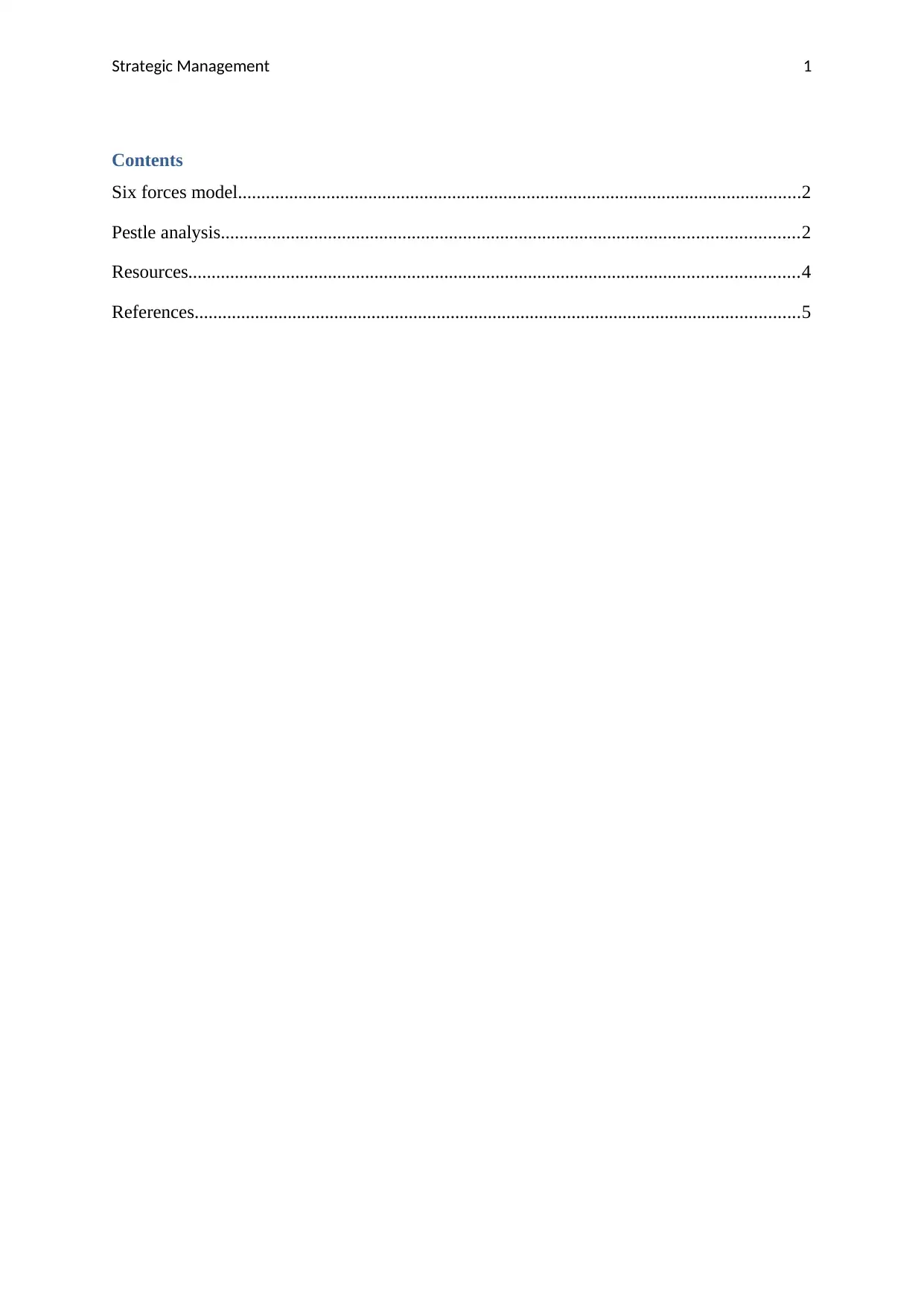
Strategic Management 1
Contents
Six forces model.........................................................................................................................2
Pestle analysis............................................................................................................................2
Resources...................................................................................................................................4
References..................................................................................................................................5
Contents
Six forces model.........................................................................................................................2
Pestle analysis............................................................................................................................2
Resources...................................................................................................................................4
References..................................................................................................................................5
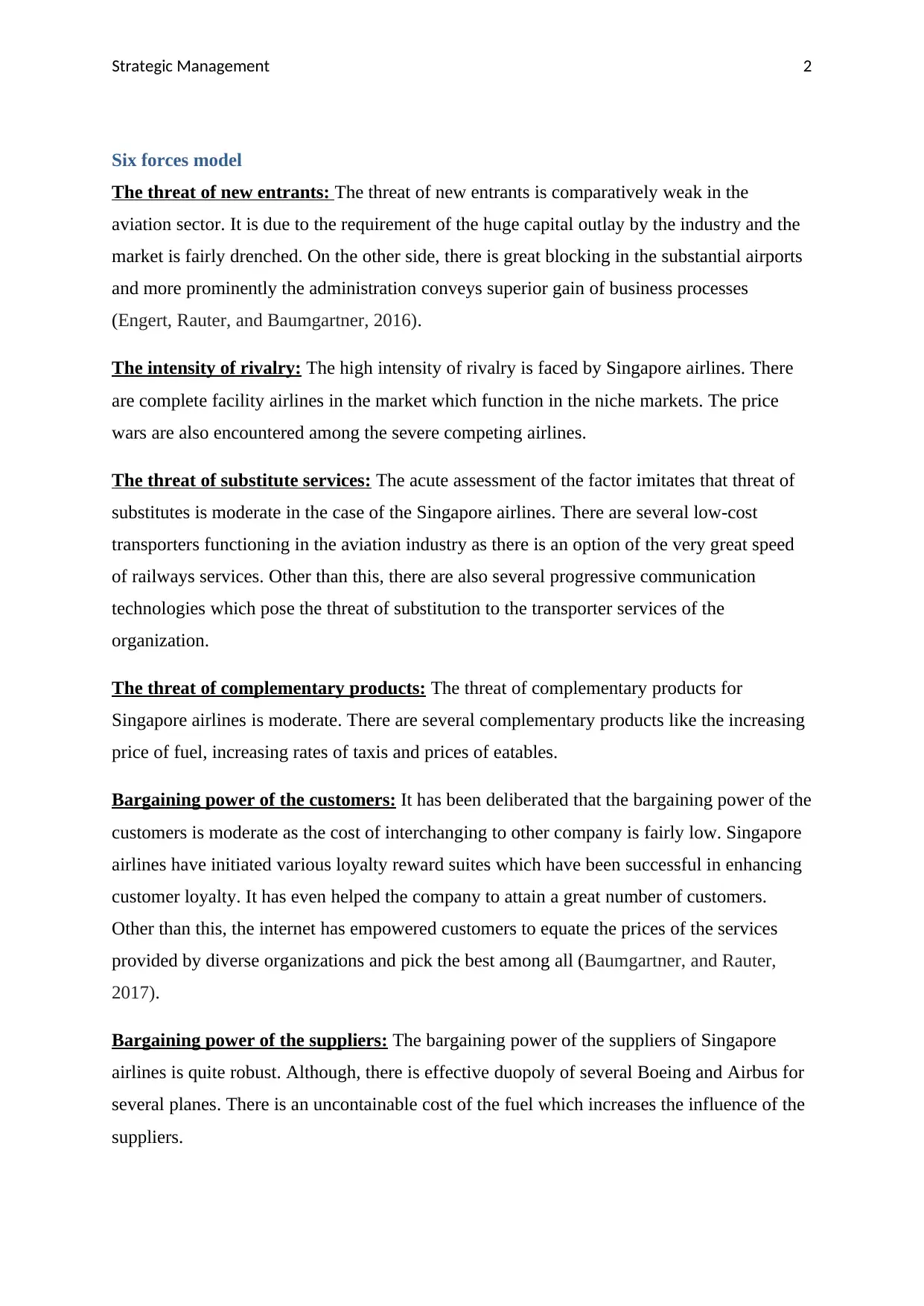
Strategic Management 2
Six forces model
The threat of new entrants: The threat of new entrants is comparatively weak in the
aviation sector. It is due to the requirement of the huge capital outlay by the industry and the
market is fairly drenched. On the other side, there is great blocking in the substantial airports
and more prominently the administration conveys superior gain of business processes
(Engert, Rauter, and Baumgartner, 2016).
The intensity of rivalry: The high intensity of rivalry is faced by Singapore airlines. There
are complete facility airlines in the market which function in the niche markets. The price
wars are also encountered among the severe competing airlines.
The threat of substitute services: The acute assessment of the factor imitates that threat of
substitutes is moderate in the case of the Singapore airlines. There are several low-cost
transporters functioning in the aviation industry as there is an option of the very great speed
of railways services. Other than this, there are also several progressive communication
technologies which pose the threat of substitution to the transporter services of the
organization.
The threat of complementary products: The threat of complementary products for
Singapore airlines is moderate. There are several complementary products like the increasing
price of fuel, increasing rates of taxis and prices of eatables.
Bargaining power of the customers: It has been deliberated that the bargaining power of the
customers is moderate as the cost of interchanging to other company is fairly low. Singapore
airlines have initiated various loyalty reward suites which have been successful in enhancing
customer loyalty. It has even helped the company to attain a great number of customers.
Other than this, the internet has empowered customers to equate the prices of the services
provided by diverse organizations and pick the best among all (Baumgartner, and Rauter,
2017).
Bargaining power of the suppliers: The bargaining power of the suppliers of Singapore
airlines is quite robust. Although, there is effective duopoly of several Boeing and Airbus for
several planes. There is an uncontainable cost of the fuel which increases the influence of the
suppliers.
Six forces model
The threat of new entrants: The threat of new entrants is comparatively weak in the
aviation sector. It is due to the requirement of the huge capital outlay by the industry and the
market is fairly drenched. On the other side, there is great blocking in the substantial airports
and more prominently the administration conveys superior gain of business processes
(Engert, Rauter, and Baumgartner, 2016).
The intensity of rivalry: The high intensity of rivalry is faced by Singapore airlines. There
are complete facility airlines in the market which function in the niche markets. The price
wars are also encountered among the severe competing airlines.
The threat of substitute services: The acute assessment of the factor imitates that threat of
substitutes is moderate in the case of the Singapore airlines. There are several low-cost
transporters functioning in the aviation industry as there is an option of the very great speed
of railways services. Other than this, there are also several progressive communication
technologies which pose the threat of substitution to the transporter services of the
organization.
The threat of complementary products: The threat of complementary products for
Singapore airlines is moderate. There are several complementary products like the increasing
price of fuel, increasing rates of taxis and prices of eatables.
Bargaining power of the customers: It has been deliberated that the bargaining power of the
customers is moderate as the cost of interchanging to other company is fairly low. Singapore
airlines have initiated various loyalty reward suites which have been successful in enhancing
customer loyalty. It has even helped the company to attain a great number of customers.
Other than this, the internet has empowered customers to equate the prices of the services
provided by diverse organizations and pick the best among all (Baumgartner, and Rauter,
2017).
Bargaining power of the suppliers: The bargaining power of the suppliers of Singapore
airlines is quite robust. Although, there is effective duopoly of several Boeing and Airbus for
several planes. There is an uncontainable cost of the fuel which increases the influence of the
suppliers.
⊘ This is a preview!⊘
Do you want full access?
Subscribe today to unlock all pages.

Trusted by 1+ million students worldwide
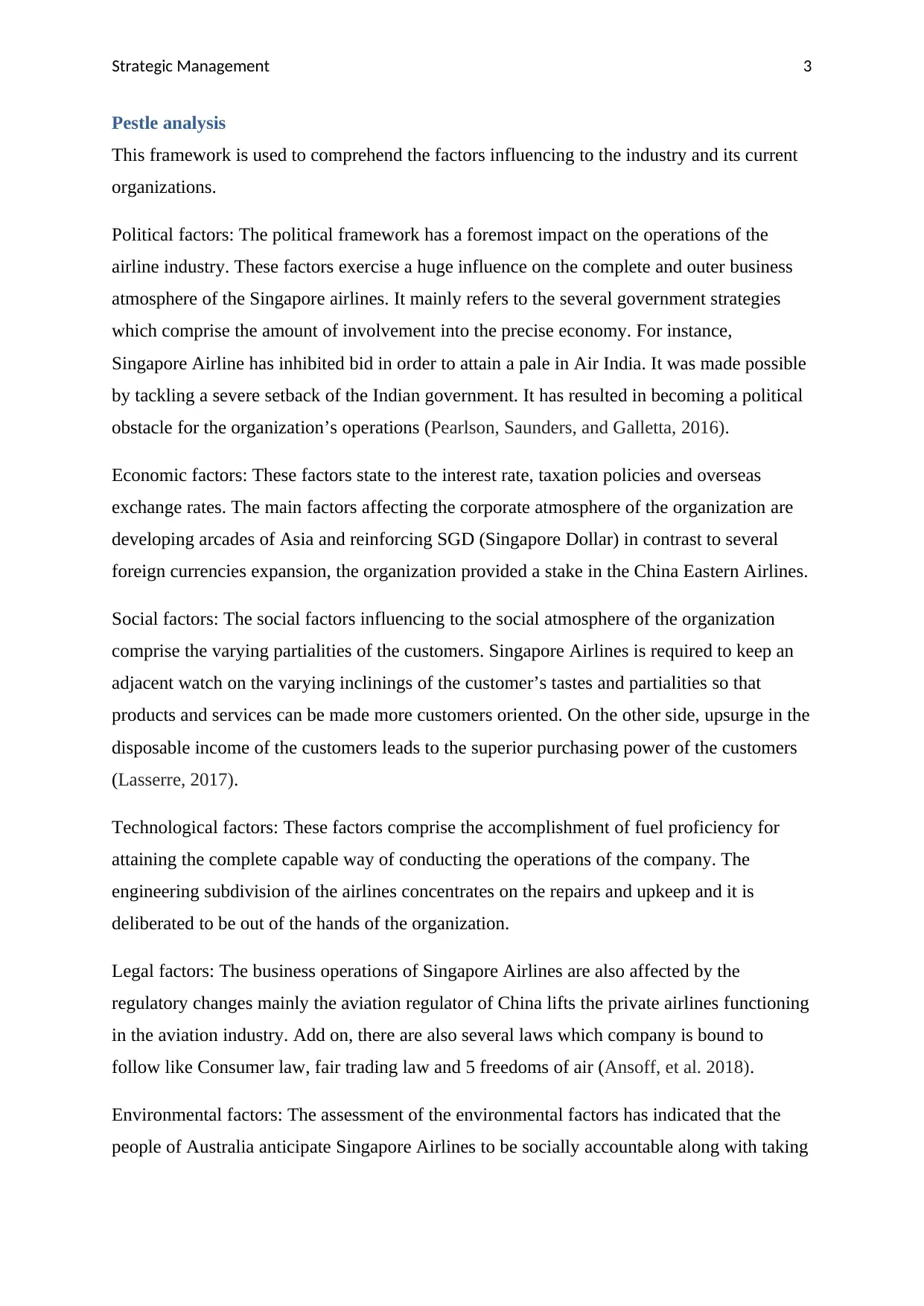
Strategic Management 3
Pestle analysis
This framework is used to comprehend the factors influencing to the industry and its current
organizations.
Political factors: The political framework has a foremost impact on the operations of the
airline industry. These factors exercise a huge influence on the complete and outer business
atmosphere of the Singapore airlines. It mainly refers to the several government strategies
which comprise the amount of involvement into the precise economy. For instance,
Singapore Airline has inhibited bid in order to attain a pale in Air India. It was made possible
by tackling a severe setback of the Indian government. It has resulted in becoming a political
obstacle for the organization’s operations (Pearlson, Saunders, and Galletta, 2016).
Economic factors: These factors state to the interest rate, taxation policies and overseas
exchange rates. The main factors affecting the corporate atmosphere of the organization are
developing arcades of Asia and reinforcing SGD (Singapore Dollar) in contrast to several
foreign currencies expansion, the organization provided a stake in the China Eastern Airlines.
Social factors: The social factors influencing to the social atmosphere of the organization
comprise the varying partialities of the customers. Singapore Airlines is required to keep an
adjacent watch on the varying inclinings of the customer’s tastes and partialities so that
products and services can be made more customers oriented. On the other side, upsurge in the
disposable income of the customers leads to the superior purchasing power of the customers
(Lasserre, 2017).
Technological factors: These factors comprise the accomplishment of fuel proficiency for
attaining the complete capable way of conducting the operations of the company. The
engineering subdivision of the airlines concentrates on the repairs and upkeep and it is
deliberated to be out of the hands of the organization.
Legal factors: The business operations of Singapore Airlines are also affected by the
regulatory changes mainly the aviation regulator of China lifts the private airlines functioning
in the aviation industry. Add on, there are also several laws which company is bound to
follow like Consumer law, fair trading law and 5 freedoms of air (Ansoff, et al. 2018).
Environmental factors: The assessment of the environmental factors has indicated that the
people of Australia anticipate Singapore Airlines to be socially accountable along with taking
Pestle analysis
This framework is used to comprehend the factors influencing to the industry and its current
organizations.
Political factors: The political framework has a foremost impact on the operations of the
airline industry. These factors exercise a huge influence on the complete and outer business
atmosphere of the Singapore airlines. It mainly refers to the several government strategies
which comprise the amount of involvement into the precise economy. For instance,
Singapore Airline has inhibited bid in order to attain a pale in Air India. It was made possible
by tackling a severe setback of the Indian government. It has resulted in becoming a political
obstacle for the organization’s operations (Pearlson, Saunders, and Galletta, 2016).
Economic factors: These factors state to the interest rate, taxation policies and overseas
exchange rates. The main factors affecting the corporate atmosphere of the organization are
developing arcades of Asia and reinforcing SGD (Singapore Dollar) in contrast to several
foreign currencies expansion, the organization provided a stake in the China Eastern Airlines.
Social factors: The social factors influencing to the social atmosphere of the organization
comprise the varying partialities of the customers. Singapore Airlines is required to keep an
adjacent watch on the varying inclinings of the customer’s tastes and partialities so that
products and services can be made more customers oriented. On the other side, upsurge in the
disposable income of the customers leads to the superior purchasing power of the customers
(Lasserre, 2017).
Technological factors: These factors comprise the accomplishment of fuel proficiency for
attaining the complete capable way of conducting the operations of the company. The
engineering subdivision of the airlines concentrates on the repairs and upkeep and it is
deliberated to be out of the hands of the organization.
Legal factors: The business operations of Singapore Airlines are also affected by the
regulatory changes mainly the aviation regulator of China lifts the private airlines functioning
in the aviation industry. Add on, there are also several laws which company is bound to
follow like Consumer law, fair trading law and 5 freedoms of air (Ansoff, et al. 2018).
Environmental factors: The assessment of the environmental factors has indicated that the
people of Australia anticipate Singapore Airlines to be socially accountable along with taking
Paraphrase This Document
Need a fresh take? Get an instant paraphrase of this document with our AI Paraphraser
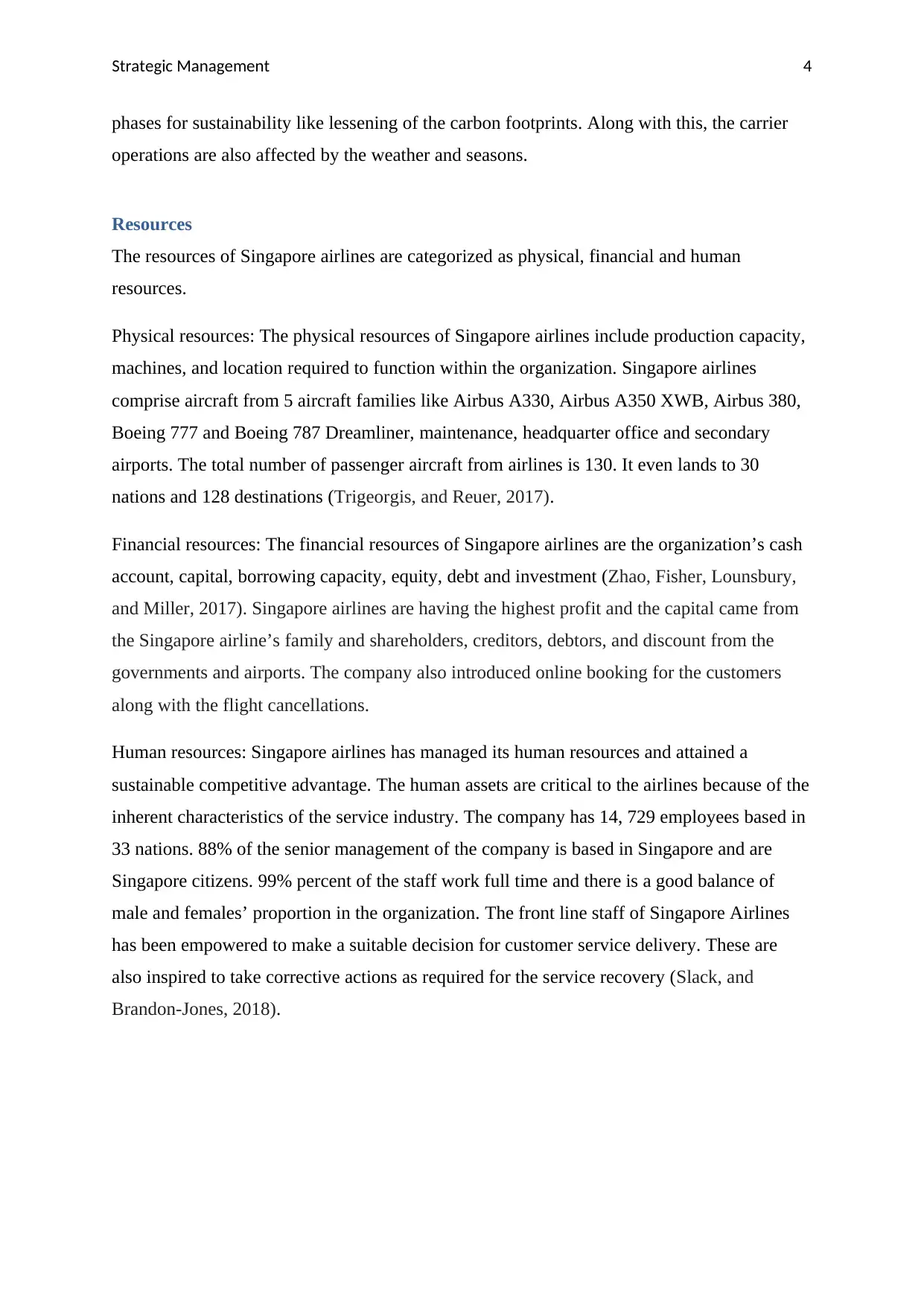
Strategic Management 4
phases for sustainability like lessening of the carbon footprints. Along with this, the carrier
operations are also affected by the weather and seasons.
Resources
The resources of Singapore airlines are categorized as physical, financial and human
resources.
Physical resources: The physical resources of Singapore airlines include production capacity,
machines, and location required to function within the organization. Singapore airlines
comprise aircraft from 5 aircraft families like Airbus A330, Airbus A350 XWB, Airbus 380,
Boeing 777 and Boeing 787 Dreamliner, maintenance, headquarter office and secondary
airports. The total number of passenger aircraft from airlines is 130. It even lands to 30
nations and 128 destinations (Trigeorgis, and Reuer, 2017).
Financial resources: The financial resources of Singapore airlines are the organization’s cash
account, capital, borrowing capacity, equity, debt and investment (Zhao, Fisher, Lounsbury,
and Miller, 2017). Singapore airlines are having the highest profit and the capital came from
the Singapore airline’s family and shareholders, creditors, debtors, and discount from the
governments and airports. The company also introduced online booking for the customers
along with the flight cancellations.
Human resources: Singapore airlines has managed its human resources and attained a
sustainable competitive advantage. The human assets are critical to the airlines because of the
inherent characteristics of the service industry. The company has 14, 729 employees based in
33 nations. 88% of the senior management of the company is based in Singapore and are
Singapore citizens. 99% percent of the staff work full time and there is a good balance of
male and females’ proportion in the organization. The front line staff of Singapore Airlines
has been empowered to make a suitable decision for customer service delivery. These are
also inspired to take corrective actions as required for the service recovery (Slack, and
Brandon-Jones, 2018).
phases for sustainability like lessening of the carbon footprints. Along with this, the carrier
operations are also affected by the weather and seasons.
Resources
The resources of Singapore airlines are categorized as physical, financial and human
resources.
Physical resources: The physical resources of Singapore airlines include production capacity,
machines, and location required to function within the organization. Singapore airlines
comprise aircraft from 5 aircraft families like Airbus A330, Airbus A350 XWB, Airbus 380,
Boeing 777 and Boeing 787 Dreamliner, maintenance, headquarter office and secondary
airports. The total number of passenger aircraft from airlines is 130. It even lands to 30
nations and 128 destinations (Trigeorgis, and Reuer, 2017).
Financial resources: The financial resources of Singapore airlines are the organization’s cash
account, capital, borrowing capacity, equity, debt and investment (Zhao, Fisher, Lounsbury,
and Miller, 2017). Singapore airlines are having the highest profit and the capital came from
the Singapore airline’s family and shareholders, creditors, debtors, and discount from the
governments and airports. The company also introduced online booking for the customers
along with the flight cancellations.
Human resources: Singapore airlines has managed its human resources and attained a
sustainable competitive advantage. The human assets are critical to the airlines because of the
inherent characteristics of the service industry. The company has 14, 729 employees based in
33 nations. 88% of the senior management of the company is based in Singapore and are
Singapore citizens. 99% percent of the staff work full time and there is a good balance of
male and females’ proportion in the organization. The front line staff of Singapore Airlines
has been empowered to make a suitable decision for customer service delivery. These are
also inspired to take corrective actions as required for the service recovery (Slack, and
Brandon-Jones, 2018).
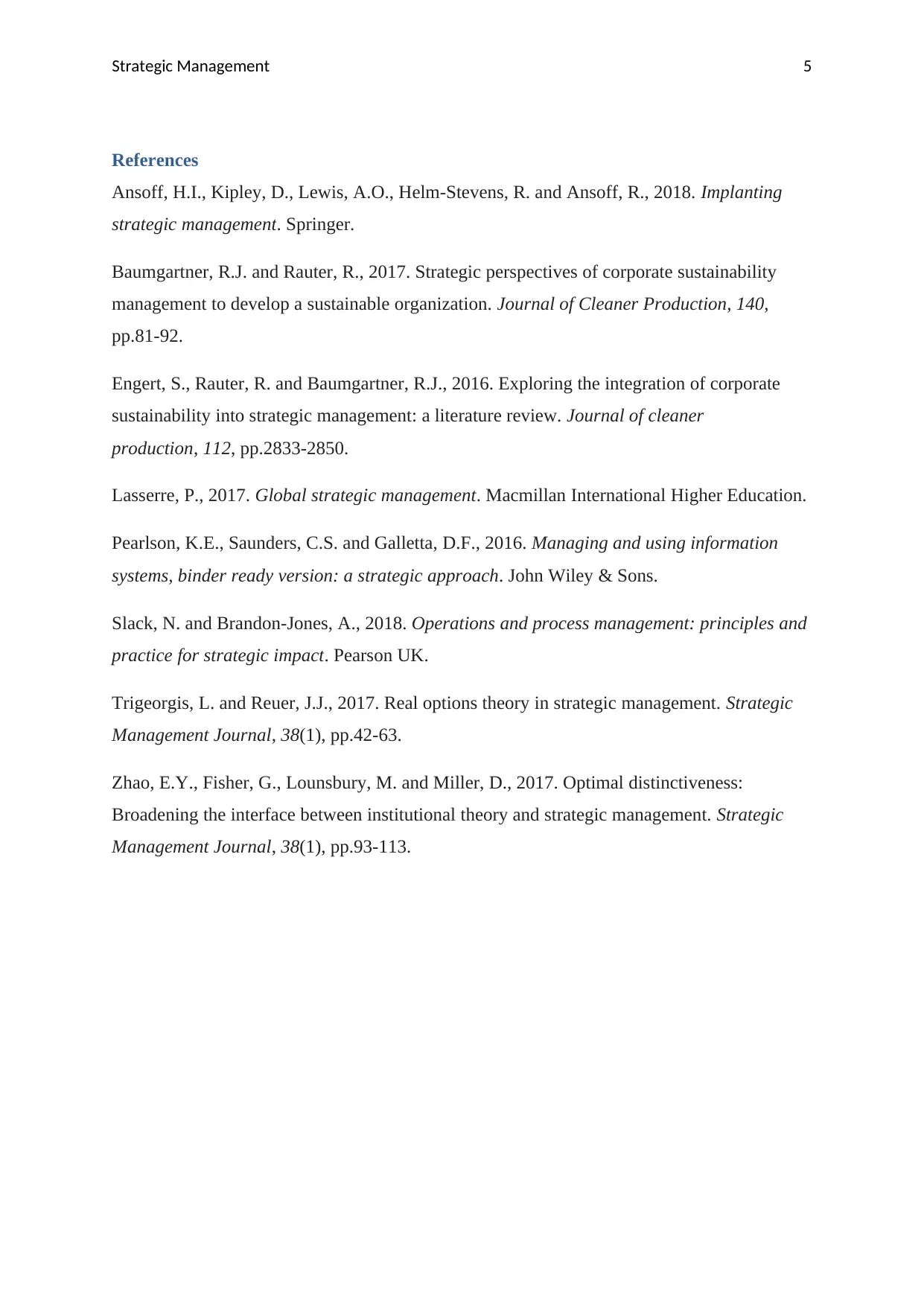
Strategic Management 5
References
Ansoff, H.I., Kipley, D., Lewis, A.O., Helm-Stevens, R. and Ansoff, R., 2018. Implanting
strategic management. Springer.
Baumgartner, R.J. and Rauter, R., 2017. Strategic perspectives of corporate sustainability
management to develop a sustainable organization. Journal of Cleaner Production, 140,
pp.81-92.
Engert, S., Rauter, R. and Baumgartner, R.J., 2016. Exploring the integration of corporate
sustainability into strategic management: a literature review. Journal of cleaner
production, 112, pp.2833-2850.
Lasserre, P., 2017. Global strategic management. Macmillan International Higher Education.
Pearlson, K.E., Saunders, C.S. and Galletta, D.F., 2016. Managing and using information
systems, binder ready version: a strategic approach. John Wiley & Sons.
Slack, N. and Brandon-Jones, A., 2018. Operations and process management: principles and
practice for strategic impact. Pearson UK.
Trigeorgis, L. and Reuer, J.J., 2017. Real options theory in strategic management. Strategic
Management Journal, 38(1), pp.42-63.
Zhao, E.Y., Fisher, G., Lounsbury, M. and Miller, D., 2017. Optimal distinctiveness:
Broadening the interface between institutional theory and strategic management. Strategic
Management Journal, 38(1), pp.93-113.
References
Ansoff, H.I., Kipley, D., Lewis, A.O., Helm-Stevens, R. and Ansoff, R., 2018. Implanting
strategic management. Springer.
Baumgartner, R.J. and Rauter, R., 2017. Strategic perspectives of corporate sustainability
management to develop a sustainable organization. Journal of Cleaner Production, 140,
pp.81-92.
Engert, S., Rauter, R. and Baumgartner, R.J., 2016. Exploring the integration of corporate
sustainability into strategic management: a literature review. Journal of cleaner
production, 112, pp.2833-2850.
Lasserre, P., 2017. Global strategic management. Macmillan International Higher Education.
Pearlson, K.E., Saunders, C.S. and Galletta, D.F., 2016. Managing and using information
systems, binder ready version: a strategic approach. John Wiley & Sons.
Slack, N. and Brandon-Jones, A., 2018. Operations and process management: principles and
practice for strategic impact. Pearson UK.
Trigeorgis, L. and Reuer, J.J., 2017. Real options theory in strategic management. Strategic
Management Journal, 38(1), pp.42-63.
Zhao, E.Y., Fisher, G., Lounsbury, M. and Miller, D., 2017. Optimal distinctiveness:
Broadening the interface between institutional theory and strategic management. Strategic
Management Journal, 38(1), pp.93-113.
⊘ This is a preview!⊘
Do you want full access?
Subscribe today to unlock all pages.

Trusted by 1+ million students worldwide
1 out of 6
Related Documents
Your All-in-One AI-Powered Toolkit for Academic Success.
+13062052269
info@desklib.com
Available 24*7 on WhatsApp / Email
![[object Object]](/_next/static/media/star-bottom.7253800d.svg)
Unlock your academic potential
Copyright © 2020–2025 A2Z Services. All Rights Reserved. Developed and managed by ZUCOL.





